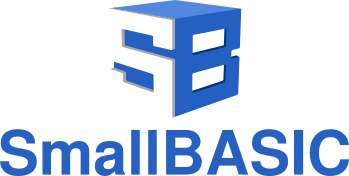SmallBASIC
SmallBASIC is a fast and easy to learn BASIC language interpreter ideal for everyday calculations, scripts and prototypes. SmallBASIC includes trigonometric, matrices and algebra functions, a built in IDE, a powerful string library, system, sound, graphic commands and communication via serial or sockets along with structured programming syntax.

Programming Made Easy for All
SmallBASIC is available for various operating systems, including Windows, Linux, and Android. You can even build it from source to run on many other POSIX-compliant systems, such as Raspberry Pi OS for the Raspberry Pi. With its built-in Integrated Development Environment (IDE), you can write programs on your Android-powered tablet or mobile phone and run them instantly.

SmallBASIC makes it easy to bundle your program with all the necessary libraries, creating executable files for Windows (exe-files) or Linux (AppImage). For Android, you can create a signed package (pkg) and distribute it through platforms like Google Play. Learn more about distributing your program on our (Distribution) page.
If you prefer an online experience, you can start programming with the web-based version of SmallBASIC in your browser right now. Just click on Start online to begin coding.
Editors, IDE and SmallBASIC versions
SmallBASIC comes in three different flavors for the desktop. The SDL version offers a simple but efficient IDE and is perfect for working with graphics. The FLTK version has a great IDE. The console version doesn’t offer an IDE and is text-only but works perfect with plugins like raylib or nuklear (Downloads).

No matter which SmallBASIC version you prefer, external editors like Visual Studio Code, Geany, Sublime Text or KDE Kate can be setup for syntax highlighting or code execution (Setup external editors).
Instructions on how to use the editor in the SDL and Android version can be found in the article Android
Units
Units are sets of functions, procedures and constants bundled in a BASIC-library and can be imported in your program. Units use their own namespace and therefore are separated from your program.
' Example for importing the CSS color-name unit
Import crgb as c
Color c.Black, c.Tomato
Print " Standard CSS Tomato background color "
Color c.Black, c.LightSteelBlue
Print " Standard CSS LightSteelBlue background color "
rect 200, 200, 400, 400 COLOR c.DeepPink filledPlugins
Plugins are libraries written in C which extent the functionality of SmallBASIC. SmallBASIC offers an API to write your own plugins. The following plugins are part of the release version of SmallBASIC: raylib (2D and 3D game development), nuklear (GUI programming), clipboard, gifencoder and WebSockets. You can also import a plugin for the Raspberry Pi to use the GPIO ports and some additional hardware like displays or temperature sensors.
' Example how to use raylib to open a window and print text.
import raylib as rl
import raylibc as c
const screenWidth = 800
const screenHeight = 450
rl.InitWindow(screenWidth, screenHeight, "raylib [core] example - basic window")
rl.SetTargetFPS(60)
while (!rl.WindowShouldClose())
rl.BeginDrawing()
rl.ClearBackground(c.RAYWHITE)
rl.DrawText("Congrats! You created your first window!", 190, 200, 20, c.LIGHTGRAY)
rl.EndDrawing()
wend
rl.CloseWindow()More information
Read more in the short user guide or in the SmallBASIC handbook. See the documentation of all SmallBASIC commands in the language reference or browse additional articles in the article section.